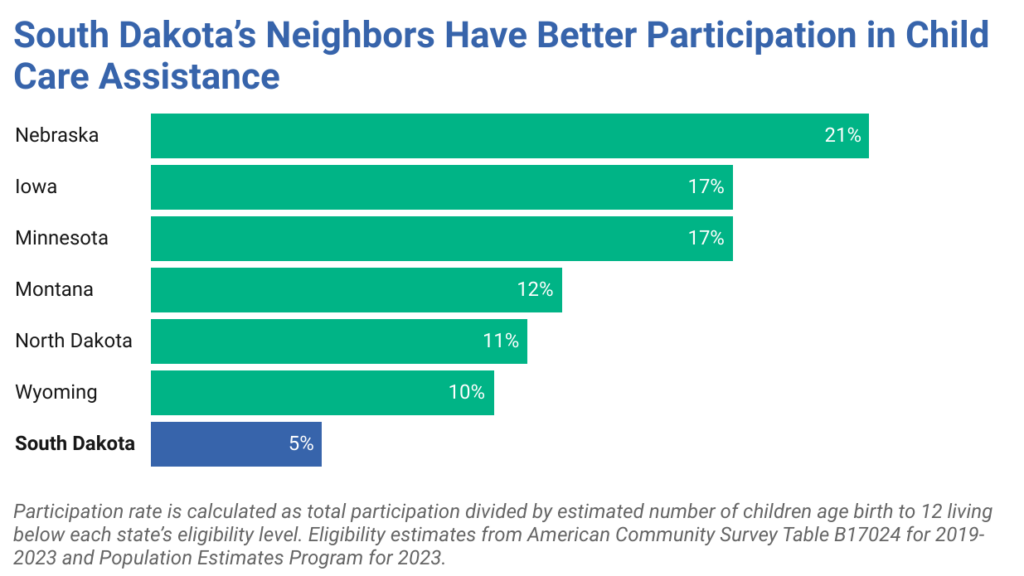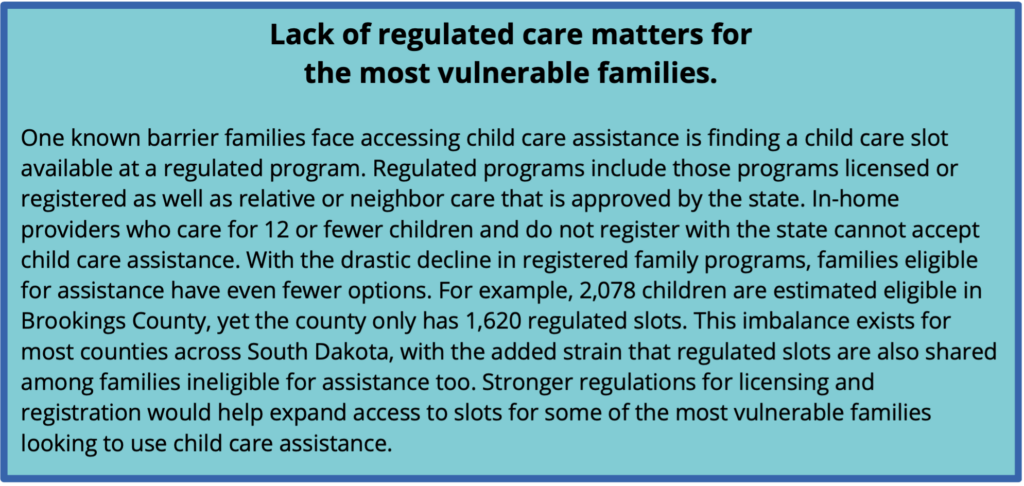Child Care Assistance: An Updated Look at the Data
January 2025
Many South Dakota families need or want some form of child care to pursue work, training, or education opportunities. In 2023, three out of four young children in South Dakota lived in families where all available parents worked.1 However, finding and affording child care is challenging across the state. Families are left to sift through a patchwork of regulated and unregulated care, waitlists, and ultimately pay high costs when they do find care. This policy brief is an updated look at key data related to child care and Child Care Assistance in South Dakota. To find a more in-depth narrative of the child care landscape, see, “Child Care Assistance Program: An Opportunity for South Dakota to Improve the Child Care System.”
Many More Families Are Eligible to Receive Child Care Assistance Than Participate
In state fiscal year 2024, 3,067 children participated in the Child Care Assistance (CCA) program in South Dakota.2 However, fewer children participated in CCA than a decade ago, with participation down 30 percent.
Approximately 59,000 children age birth to 12 fall below the income eligibility, yet only 5 percent receive child care assistance.3 Low participation rates for CCA are a common trend across the country. However, South Dakota falls quite a bit lower than the national average of 23 percent.4 South Dakota’s rates are lower than neighboring states, too, signaling additional barriers keeping families from using this program. Removing barriers and improving access to CCA is an important strategy for addressing child care challenges across the state.

One Barrier for Families to Use Child Care Assistance Is Simply Finding an Available Spot
Programs must be regulated by the state to accept CCA. Child care in South Dakota remains a patchwork of regulated and unregulated care, with little data available to understand unregulated options.
In 2024, 765 programs were licensed or registered with the state providing slots for 18,043 school-age children and 32,437 slots at a family or center-based program.5 Family homes that voluntarily register with the state have declined in the last decade, with only half the number of registered programs in 2024 (354 registered programs) compared to 2014 (729 registered programs). Since program registration is voluntary, it is impossible to know whether this decline is due to fewer family-based programs with less than 13 children existing, or if fewer programs are choosing to register.

Parents Alone Cannot Pay What High-Quality Care Costs
For families that do find child care, the cost is often out of reach. The cost for full-time child care varies based on age, the type of facility, and geographic location within South Dakota. Parents pay, on average, $7,862 per year for center-based care and $5,824 per year for family-based child care.6 However, local rate surveys show that costs are significantly higher in Sioux Falls, where parents pay $7,785 on average per year for an in-home program and $12,400 on average per year for a center-based program.7
While child care makes up a big expense for families, child care workers make low wages despite the value of their essential work. Child care programs are left to figure out how to balance the true cost of providing high-quality care with what parents can afford. This often means providers struggle to offer competitive pay and benefits to their staff. In 2023, the median wage for a child care worker in South Dakota was $12.67 per hour, the second lowest median wage for any occupation.8 This translates to $26,350 per year if working full-time, hovering just above the poverty level for a family of three.9 Low wages for child care workers leads to staffing instability, making it challenging for child care businesses to retain workers and remain open.
Conclusion: South Dakota’s Child Care Assistance Is an Opportunity to Improve Child Care Across the State
South Dakota can learn from other states to implement proven strategies for improving Child Care Assistance. Increasing state reimbursement rates, either using a cost-of-care model (like New Mexico) or creating bonuses for certain high-needs groups (like North Dakota’s infant and toddler bonuses), can help more closely match the true cost of providing high-quality care. Making all child care workers categorically eligible for CCA, is a proven strategy in other states (Kentucky, North Dakota, Iowa, and Maine) to reach more families and help stabilize the child care workforce. Last, removing barriers families face to access CCA, like removing the child support requirement, can help boost South Dakota’s low participation rate.
Footnotes
- KIDS COUNT Data Center, “Children With All Available Parents in the Labor Force by Age in South Dakota,” 2019-2023.
- KIDS COUNT Data Center, “Child Care Assistance Recipients in South Dakota,” 2024.
- Eligible children (denominator of percentage) are calculated as the number of children matching each age category based on 2023 population estimates multiplied by the percent of children living below 200 percent of the federal poverty level from table B17024. KIDS COUNT Data Center, “Child Population by Single Year of Age in South Dakota,” 2023. U.S. Census Bureau, “Age by Ratio of Income to Poverty Level in the Past 12 Months, 2019-2023 American Community Survey 5-Year Estimates, Table B17024,” accessed on Jan. 13, 2025.
- Chien, N. “Factsheet: Estimates of Child Care Eligibility & Receipt for Fiscal Year 2019,” Office of the Assistance Secretary for Planning & Evaluation, Sep. 2022.
- KIDS COUNT Data Center, “Licensed or Registered Child Care Providers in South Dakota,” 2024; KIDS COUNT Data Center, “Licensed or Registered Child Care Capacity in South Dakota,” 2024; KIDS COUNT Data Center, “Licensed Before and After School Programs in South Dakota,” 2024; KIDS COUNT Data Center, “Licensed Before and After School Program Capacity in South Dakota,” 2024.
- Child Care Aware of America, “Child Care Affordability in South Dakota,” 2022.
- Sioux Falls Childcare Collaborative, “Community Childcare Initiative Final Report,” Jun. 2023.
- U.S. Bureau of Labor Statistics, “May 2023 State Occupational Employment and Wage Estimates, South Dakota,” accessed on Jan. 13, 2025.
- U.S. Office of the Assistance Secretary for Planning and Evaluation, “HHS Poverty Guidelines for 2024,” accessed on Jan. 13, 2025.

